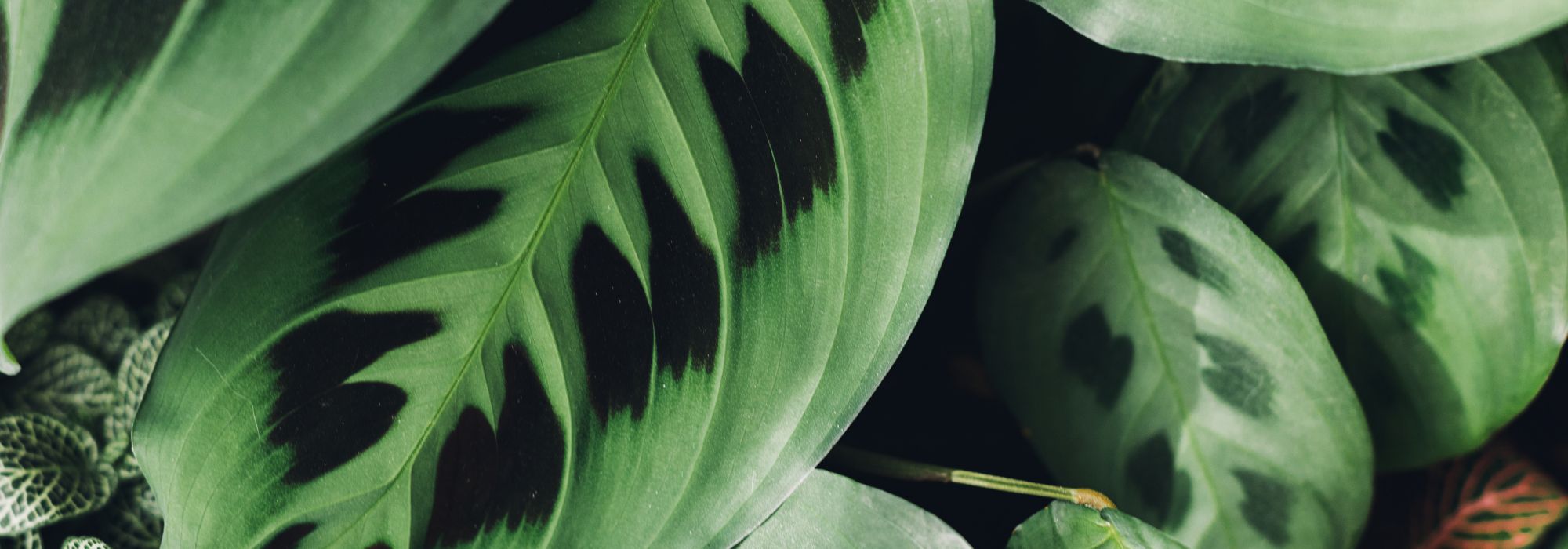
Maranta - Prayer plant : growing and caring
Contents
Marantas in a nutshell
- The maranta, or prayer plant, is a tropical plant with striking foliage that folds up at night due to nastic movement.
- They thrive in indirect light, a well-draining substrate, and high humidity to grow well.
- Their care involves moderate watering and regular misting.
- Marantas can be easily propagated by dividing the clumps.
- Perfect for decoration, they enhance jungle, bohemian, or minimalist interiors.
The word from our expert
The marantas, or prayer plants, belong to the Marantaceae family and fascinate with their graphically patterned and colourful foliage. Native to the tropical forests of South America, they owe their name to their unique nocturnal movement, nyctinasty, which causes their leaves to fold up like hands in prayer. Well-suited to indoor cultivation due to their tolerance for filtered light and love of humidity, they add an elegant and air-purifying touch of greenery to any living space.
Easy to care for, marantas require a light, well-draining substrate, regular but not excessive watering, and sufficient ambient humidity to maintain their vibrancy.
In terms of décor, marantas fit perfectly into an urban jungle, bohemian, or minimalist interior. Their slightly trailing habit is enhanced by colourful ceramic pots, rattan, or glazed terracotta, and they pair beautifully with other tropical plants like calatheas and monsteras. If you’re looking for an original, easy-to-care-for, and decorative plant, the maranta is an ideal choice.

There are many varieties of marantas. A great idea for a collection.
Botany and description
Botanical data
- Latin name Maranta sp.
- Family Marantaceae
- Common name Prayer plant, Maranta
- Flowering from spring to autumn
- Height 30 cm
- Exposure partial shade or bright, without direct sunlight
- Soil type peat-rich and well-drained
- Hardiness frost-sensitive
Marantas, also known as prayer plants, belong to the Marantaceae family (like Calatheas), a botanical genus comprising several tropical species with ornamental foliage. Their genus name, Maranta, pays homage to the Venetian botanist and physician Bartolomeo Maranta, who made significant contributions to the study of medicinal plants in the 16th century. In French, they are often referred to as maranta, prayer plant, or “plante-qui-prie”, and more rarely as arrowroot herb, due to their leaves folding vertically at night, a phenomenon reminiscent of hands clasped in prayer.
In their natural habitat, marantas thrive in the humid tropical forests of Central and South America, where they flourish under the dense shade of trees, benefiting from rich soil and a warm, humid atmosphere. Their ability to tolerate low light and their spectacularly patterned foliage explain why they have become highly sought-after houseplants. Easy to care for as long as their humidity and filtered light requirements are met, they add an exotic and lively touch to any interior.
Among the most commonly cultivated species and varieties, Maranta leuconeura stands out for its foliage adorned with veins and coloured spots. This species includes several popular varieties, such as ‘Fascinator’, with leaves veined in red and marked with dark green spots, or ‘Kerchoveana’, nicknamed “rabbit’s foot maranta” for its oval chocolate-brown spots resembling animal footprints.
Marantas have a low, spreading habit, often creeping or slightly bushy, making them ideal plants for hanging baskets or wide pots where their foliage can spread. They grow mainly in compact clumps, with slender, flexible stems that extend horizontally rather than growing tall. Some varieties, like Maranta leuconeura ‘Fascinator’, display a slightly trailing habit.
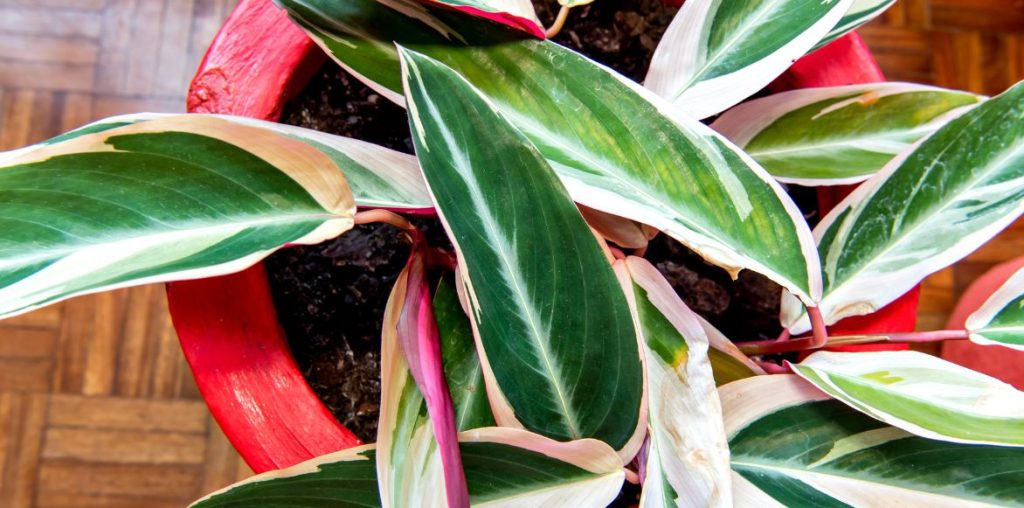
Maranta arundinacea ‘Variegata’ boasts variegated foliage.
Their root system is rhizomatous, characterised by tuberous roots that allow them to store water and nutrients. This trait gives them good resistance to periods of relative drought, although their need for humidity remains important for healthy growth. The rhizomes also facilitate propagation by division, a common method in cultivation.
Marantas develop herbaceous, short, creeping stems that directly connect the root system to the foliage. They emerge in clusters from the base of the plant, forming a dense clump that gradually spreads.
The foliage is undoubtedly the most spectacular characteristic of marantas. Their oval to elliptical leaves are borne on long petioles and display striking graphic patterns. The lamina texture is often slightly velvety, with an upper surface adorned with prominent veins and contrasting spots, while the underside is typically tinged with purple. These leaves also have the unique ability to fold upwards at night, a phenomenon linked to a natural mechanism called nyctinasty*.
Although primarily grown for their foliage, marantas are also capable of flowering, though their blooms are more discreet than those of calatheas. They produce small tubular flowers in white, pink, or mauve hues, clustered in sparse inflorescences at the tips of slender stems. In Maranta arundinacea, a species cultivated for its edible starch (arrowroot), flowering remains modest and unspectacular compared to the foliage. Rarely, some species, like Maranta subterranea, have asymmetrical flowers, lacking any symmetry.
In their natural environment, marantas can produce small capsular fruits, but this is rarely observed in pots, as conditions are not always ideal for completing this process.
*Nyctinasty is a natural movement of leaves in response to changes in light, caused by cells at the base of the petiole that regulate water pressure. This nyctinasty allows marantas to reduce nocturnal moisture loss by limiting leaf exposure to the surrounding air, which is particularly useful in their tropical habitat. It may also play a role in protecting against nocturnal herbivores or promoting rainwater runoff along the leaves to prevent stagnation and reduce the risk of fungal diseases.

The Maranta leuconeura ‘Fascinator’ reveals tricolour foliage.
Read also
Calathea : varieties, growing and careWhen and how to plant a maranta in a pot for indoors?
When to plant a maranta?
The best time to plant a maranta in a pot is in spring or summer, when the plant is in full growth and adapts more easily to its new environment. Avoid winter, as the plant slows down its activity and may struggle to recover.
What substrate to use?
Marantas prefer a light, well-draining, and organic-rich soil. The ideal mix is:
- 1/3 houseplant compost for nutrients,
- 1/3 turf or coconut fibre to retain moisture,
- 1/3 perlite or coarse sand to ensure good drainage.
Adding activated charcoal can also help prevent mould.
Alternatively, a good indoor plant compost will do the trick.
Where to place your maranta?
- Exposure: it thrives in soft, indirect light. Place it near an east or north-facing window, or a few metres away from a south or west-facing window, avoiding direct sunlight which can scorch its foliage.
- Temperature: between 18 and 25°C, avoiding draughts and temperatures below 15°C.
- Ambient humidity: it loves a humid atmosphere, around 60-70%. If the air is too dry, use a humidifier, a tray with clay pebbles and water under the pot, or mist its leaves regularly.
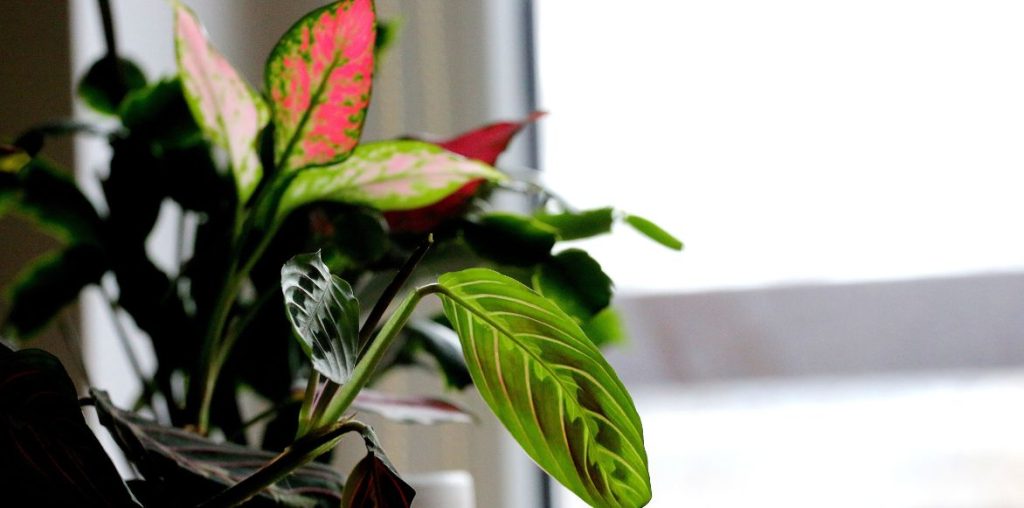
The maranta prefers filtered light.
Which pot to choose?
- Material: it’s rare to recommend this, but opt for a plastic or glazed terracotta pot, as they retain moisture better than unglazed terracotta, where the substrate dries out too quickly.
- Size: choose a pot slightly larger than the root ball, as a pot that’s too wide retains too much water and increases the risk of root rot. A diameter 2 to 3 cm larger than the root ball is sufficient. Ensure it has drainage holes.
How to plant a maranta in a pot?
- Prepare the pot: place a drainage layer (clay pebbles or gravel) at the bottom to prevent waterlogging.
- Add substrate: partially fill the pot with your compost-turf-perlite mix.
- Remove the plant from its pot: gently take the maranta out of its original pot. If the roots are tightly packed, loosen them carefully.
- Position the plant: place the maranta in the centre of the pot and add substrate around it, lightly pressing to avoid air pockets. Ensure the base of the stems is at the same level as in the old pot.
- Water generously: after planting, water thoroughly to moisten the substrate and help the plant settle.
- Place the plant in its final spot and monitor the substrate’s moisture in the following days.
Repotting
Repotting is needed every 2 to 3 years, in spring, when the roots completely fill the pot and start to emerge. It’s also a chance to refresh the substrate, divide the plant if it’s too dense, and remove damaged roots.
Staking with a support
Some varieties, like Maranta leuconeura ‘Fascinator’, may have a slightly trailing or scattered growth. If you want to give them a more upright and tidy shape, use a moss or bamboo stake. Gently tie the stems with soft ties, without tightening too much to avoid damage. This staking also helps optimise each leaf’s exposure to light and adds an aesthetic touch to the plant.
Growing and care of Prayer plants
Watering: maintain consistent moisture without excess
Marantas prefer a substrate that is always slightly moist but never waterlogged. Overwatering can lead to root rot, while insufficient water causes the leaves to dry out.
- Frequency: water approximately 1 to 2 times per week in spring and summer, and reduce in winter to every 10 to 15 days, depending on the ambient temperature.
- Water quality: use non-calcareous water (rainwater, filtered, or left to stand for 24 hours) to prevent leaf yellowing.
- Method: water directly into the substrate until water drains from the bottom of the pot. Avoid letting water stagnate in the saucer.
Additionally, mist the leaves regularly with lukewarm water to maintain good humidity, especially if the surrounding air is dry.
Fertilisation: moderate but regular feeding
- Period: fertilise from spring to autumn, every two weeks.
- Fertiliser type: a liquid fertiliser for green plants, rich in nitrogen (N) and potassium (K), promotes dense and colourful foliage.
- Dosage: you can dilute the fertiliser to half the recommended dose to avoid excess mineral salts, which could burn the roots.
In winter, stop or space out fertilisation, as the plant enters a dormant period and consumes fewer nutrients.
Pruning: minimal maintenance
Pruning marantas is rarely necessary, but it can help maintain a vigorous and well-shaped plant.
- Remove damaged leaves: if some leaves yellow or dry out, cut them at their base with clean scissors to stimulate new shoot growth.
- Encourage branching: to achieve a denser plant, you can pinch the tips of the stems, which encourages the production of new lateral shoots.
Precautions for optimal growth
- Avoid drafts and temperature fluctuations, which stress the plant and can cause the leaves to fold during the day.
- Protect the plant from lime: watering with hard water can lead to brown spots and chlorosis (leaf yellowing).
- Monitor signs of stress: brown leaf edges indicate overly dry air, wilting may signal over- or under-watering, and leaves losing their colour can be a sign of insufficient light or fertiliser.
Potential Parasitic and Disease Issues in Marantas
Common Parasites
-
Red spider mites: These tiny mites appear when the air is too dry. They can be identified by the presence of fine webs under the leaves and a gradual yellowing of the foliage. To prevent them, maintain good humidity by regularly misting the plant. In case of infestation, use a jet of lukewarm water, diluted black soap, or a natural acaricide.
-
Scale insects: They appear as small white cottony bumps or brown shells attached to stems and leaves. They weaken the plant by sucking its sap. A treatment with a cotton swab soaked in 70° alcohol, black soap, or neem oil will help eliminate them gradually.
-
Thrips: These small black or brown insects leave silvery traces on the foliage and cause a general weakening of the plant. To limit their spread, increase humidity and use yellow sticky traps or an organic insecticide in case of severe infestation.
-
Aphids: Less common, they sometimes settle on young shoots and suck the sap, deforming the leaves. A rinse under water followed by a treatment with black soap is usually enough to eliminate them.
Possible Diseases
-
Botrytis (or grey mould): Caused by excess humidity and poor ventilation, this fungal disease manifests as brown, fuzzy spots on the leaves. To prevent it, ensure good air circulation around the plant and reduce watering. In case of attack, remove affected parts and apply a natural fungicide based on copper or baking soda.
-
Root rot: The result of overwatering or poor drainage, it causes blackening of the roots and a general collapse of the plant. If the roots are soft and brown, repot urgently in a dry, well-draining substrate after cutting away the rotten parts.
-
Leaf spots: Often caused by a fungus, they appear as brown or black marks on the leaves. Avoid wetting the foliage during watering and treat with a natural fungicide if necessary.
How to propagate marantas?
Dividing clumps (the quickest method)
This is the most effective and commonly used method, typically done during repotting in spring.
Steps:
- Remove the plant from its pot: gently take the maranta out of its pot and lightly shake the root ball to loosen the roots.
- Separate the clumps: identify the natural sections with well-formed roots and carefully detach them by hand or with a clean, sharp knife.
- Repot the new plants: place each division in a pot slightly larger than its root ball, filled with a light and well-draining substrate (houseplant compost, turf, and perlite).
- Water and place in shade: moisten the substrate well after planting and keep the plant in a bright spot, but out of direct sunlight.
Advantage: this method yields mature, self-sufficient plants that quickly resume their growth.
Stem propagation (slower but effective)
Propagation by cuttings is another option for multiplying marantas, though it is a bit slower than division.
Steps:
- Choose a healthy stem: select a vigorous stem with at least 2 to 3 leaves and a node (the area where leaves emerge).
- Make a clean cut: using clean pruning shears, cut just below a node.
- Place in water: put the cutting in a glass of water, ensuring the node is submerged but not the leaves. Change the water every 2 to 3 days to prevent mould.
- Wait for roots to appear: after 2 to 4 weeks, roots will begin to develop.
- Plant in soil: once the roots are at least 2-3 cm long, transplant the cutting into a pot with a light, well-draining substrate.
- Monitor moisture: water lightly and place the young plant under filtered light in a humid environment (a transparent plastic bag can be temporarily placed to increase humidity).
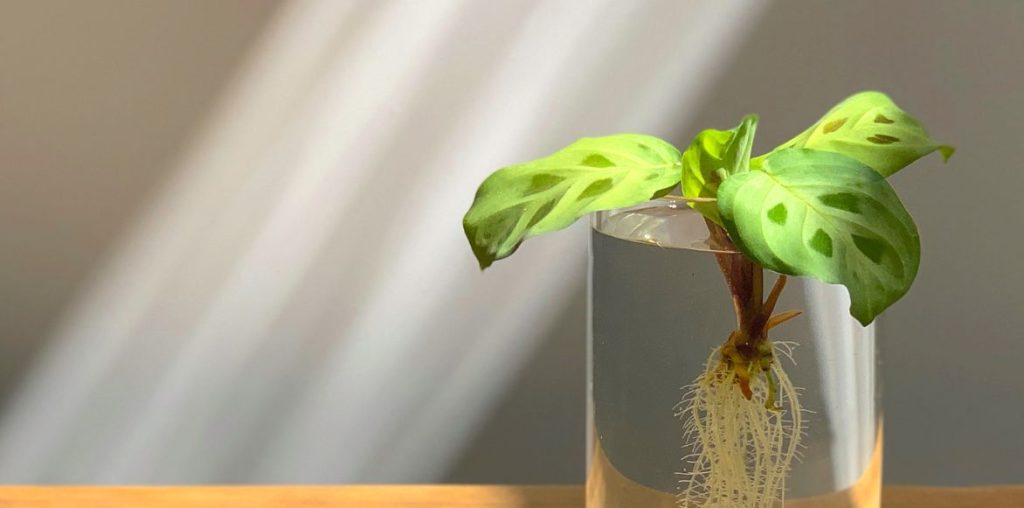
This young maranta shoot is ready to be potted.
How to best showcase a prayer plant?
What type of interior do marantas thrive in?
- Urban jungle style: paired with other tropical plants like calatheas, monsteras, or philodendrons, they create a lush and calming effect, perfect for a living room or bedroom.
- Bohemian and cosy vibe: their trailing foliage pairs well with wicker baskets, macramé, and light-coloured wood furniture.
- Minimalist and modern decor: in a sleek interior, a maranta placed in a stylish pot (white, black, concrete, or smooth ceramic) adds a touch of softness and sophistication with its textured foliage.
- Tropical chic or vintage style: with rattan furniture, brass accents, and warm colours (terracotta, forest green, ochre), it perfectly complements a 70s-inspired or exotic decor.
What type of pot showcases a maranta best?
The choice of pot influences the overall aesthetics of the plant and its surroundings.
- Textured or glazed ceramic pots: ideal for adding an elegant and colourful touch, especially in shades of green, blue, or terracotta that evoke nature.
- Glazed terracotta pots: retain substrate moisture and add a handmade, warm feel.
- Rattan or wicker planters: perfect for enhancing a bohemian and natural ambiance, playing with organic materials.
- Hanging or elevated pots: to highlight the slightly trailing habit of certain varieties (Maranta leuconeura ‘Fascinator’), creating a very aesthetic cascading effect.
Decor tip: pair the maranta with plants of varying heights and textures for a harmonious jungle effect. Soft lighting near the plant will also highlight its patterns and beautiful colours!

On the right, Maranta leuconeura – On the left, Maranta leuconeura ‘Tricolor’
Also worth reading...
→ Discover our wide range of houseplants.
- Subscribe!
- Contents
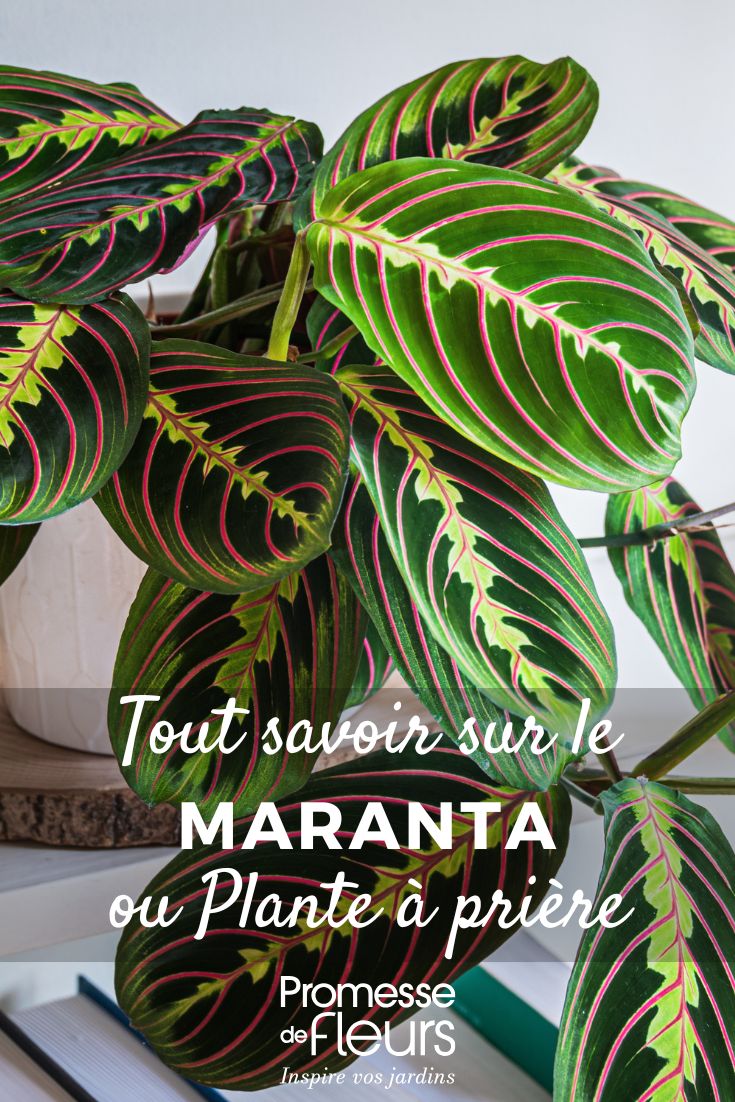































Comments